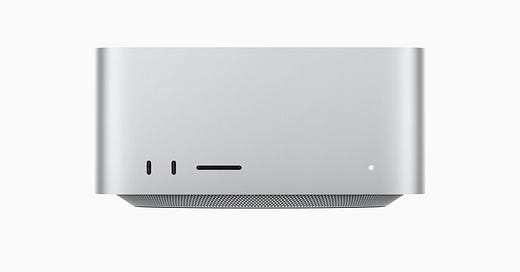What you need to know about the new Mac Studio (M4 Max or M3 Ultra), the Mac that’s (probably) not for you
Apple this week unveiled a new Mac Studio. If the “not for you” comment in the title seemed harsh, it’s not for me either. The ideal customer for this product is a professional who needs a massive amount of CPU, GPU, and NPU compute power for tasks like video editing, 3D animation, photography, and (and Apple really highlighted this one) large local LLMs for AI.
The previous generation featured the M2 Max and M2 Ultra chips. The new model features the M4 Max (no surprise) and the M3 Ultra. That’s right, an Ultra chip based on last generation M-series technology. Over on X, Sebastiaan de With of Halide responded thusly:
Perhaps the simplicity of the M-chip naming scheme is just a little too much. The double-die Ultra chips could’ve perhaps had their own letter, like P, or U — M4 Max vs. P3 would be understandable.
He’s got a good point, but while the M4 Max/M3 Ultra naming convention seems confusing to most people reading about the new Mac Studio, I don’t think Apple’s too concerned that this product’s actual customers will be confused. The people that need this much horsepower understand the technical details and aren’t going to accidentally spend $14,099 (the maximum configurable price) only to feel taken advantage of later because it didn’t ship with an M4 Ultra. Ben Bajarin, an industry analyst, was apparently told by Apple explicitly that there will be no M4 Ultra in the future (based on his comments on X):
However, I can confirm M4 does not have the Ultra Fusion connector and there is no M4 Ultra planned. Ultra does not need to be an every year cycle, and that is likely the case in future.
Still, the jump to the M3 family for the new Ultra chip does mean that hardware ray tracing is available, bringing new capabilities for high-end gaming, design, VR, animation, etc. The new Studio can also be configured up to a whopping 512 MB of unified memory. Apple says that’s the most ever in a personal computer. Unified memory can be allocated as needed for CPU and GPU tasks.
Regarding AI and machine learning, Apple says the following about its new chip:
A powerful 32-core Neural Engine fuels AI and machine learning (ML), and powers Apple Intelligence, the personal intelligence system that puts powerful generative models right at the core of the new Mac Studio. In fact, M3 Ultra is built for AI, [emphasis mine] including ML accelerators in the CPU, Apple’s most powerful GPU, the Neural Engine, and over 800GB/s of memory bandwidth. AI professionals can use Mac Studio with M3 Ultra to run large language models (LLMs) with over 600 billion parameters directly on device, making it the ultimate desktop for AI development.
Apple’s behind in AI, but they understand the importance of it in the 2020s and beyond, and they’re clearly positioning this Mac and this chip to be a compelling choice for those working with advanced models, which means they understand that people want and need to do more than just work with Apple Intelligence.
One note about this week’s announcement is that it didn’t include an update to the Mac Pro, which still just features the M2 Ultra chip. Is that just a reflection of the Mac Pro’s diminished role in the lineup, or does Apple have another Mac Pro-specific announcement for later this year? It’s going to be interesting to find out.
Your Apple Update is a reader-supported publication. If you enjoy this publication, please consider becoming a paid subscriber.




